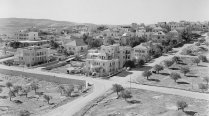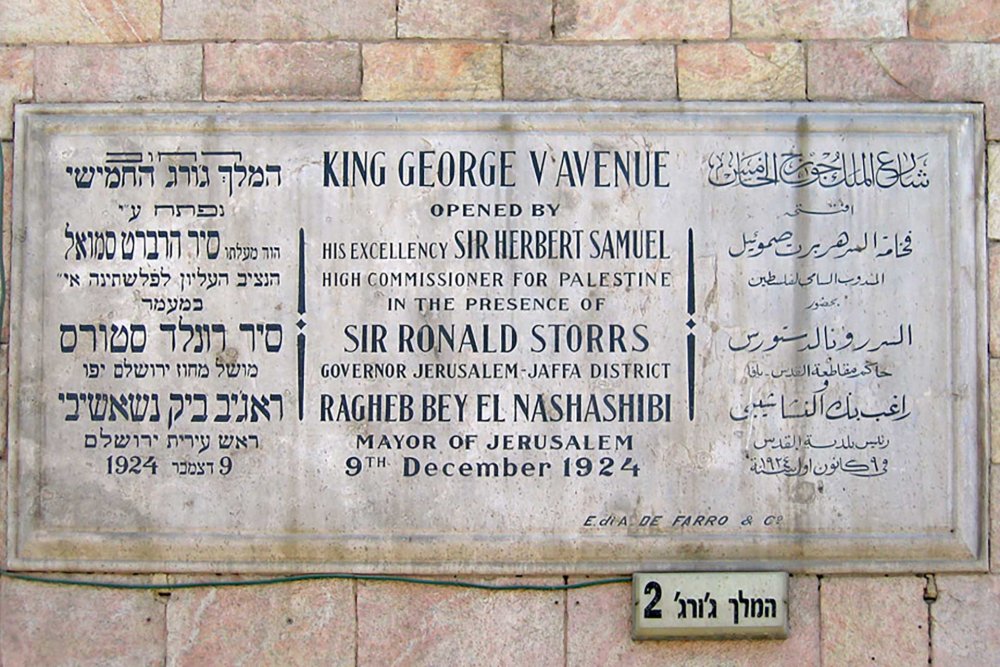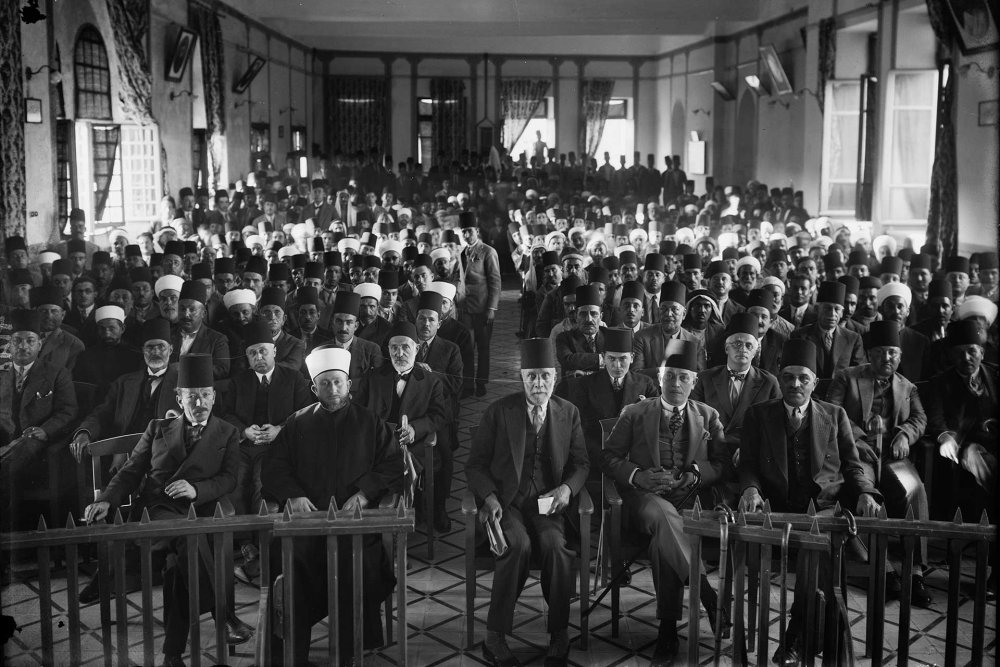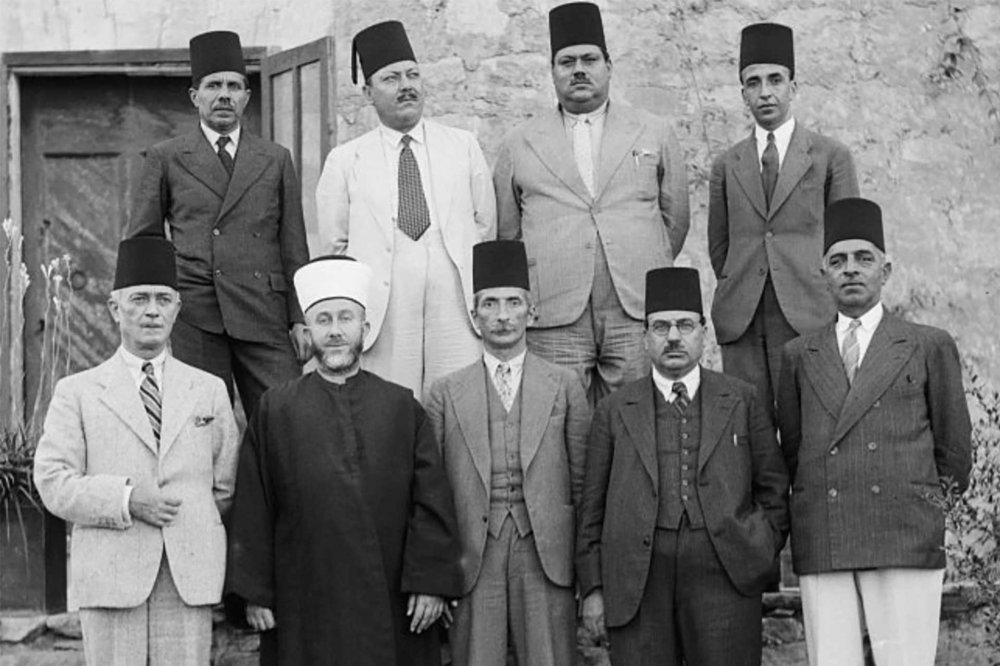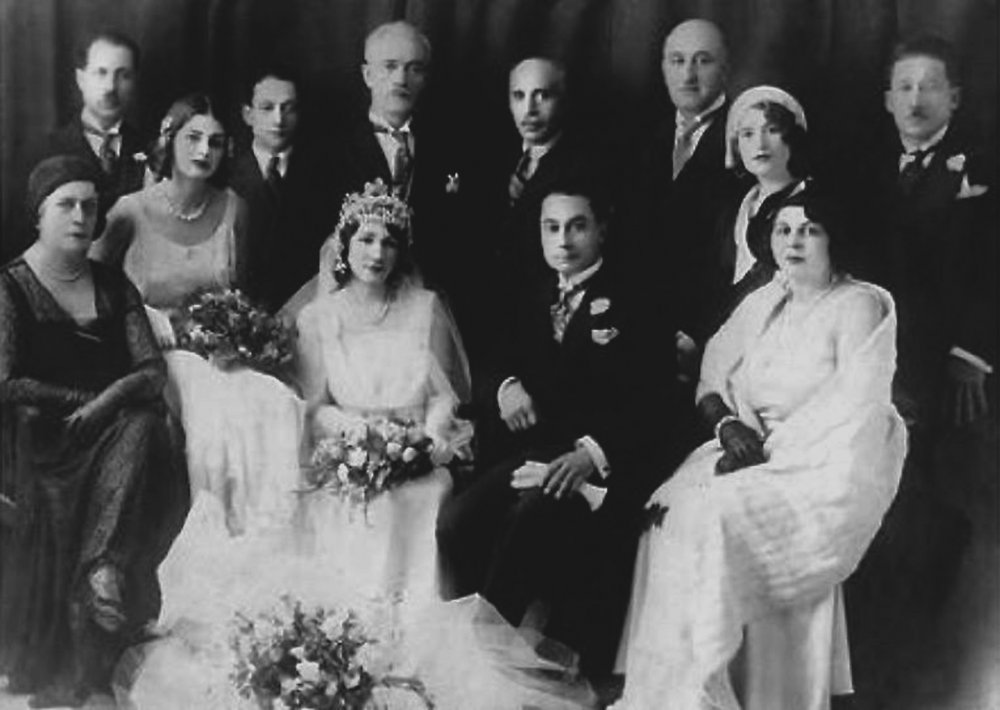Raghib al-Nashashibi was a trained civil engineer who embraced politics at a turbulent time in Palestine’s history and served as mayor of Jerusalem for 14 years, overseeing many public works projects and earning him a reputation as the city’s modernizer.
Family Prominence and Education
Al-Nashashibi was born into privilege in Ottoman Jerusalem in 1882. Over centuries, the Nashashibis had become one of the most prominent Muslim families in the city, holding influential positions as merchants, landowners, public figures, and government officials. In fact, Raghib’s father, Rashid Nashashibi, was part of the governing council of the Mutasarrifate of Jerusalem, the special administrative status the Ottomans assigned the district of Jerusalem in 1872, which extended westward to Jaffa and Gaza on the coast and to Hebron and Bir al-Sab’ in the south. He was a wealthy landowner who also had a business trading food and wheat in the Arab world.
Given the family’s prominence during Ottoman rule, Rashid sent his son Raghib to Jerusalem’s Maktab Sultani for his secondary education,1 where he received a prestigious civil (and not military) Ottoman education.2 Following high school, al-Nashashibi traveled to Istanbul, where he attended an Ottoman university and completed a degree in civil engineering.
Rise to Political Prominence
The late 19th and early 20th centuries were politically volatile in Istanbul and the Ottoman provinces. In 1889, Turkish revolutionaries, determined to keep the sultan’s power in check and strengthen a weakening multinational empire, formed the Committee of Union and Progress (CUP) and pushed to restore the Ottoman constitution. Following years of liberal reformist activism, the CUP led the 1908 Young Turk Revolution, effectively ending the sultan’s absolute power and ushering in the Second Constitutional Era.3
These tumultuous events coincided with al-Nashashibi’s time in Istanbul, during which he was a member of the CUP. In 1908, he was elected deputy of Jerusalem in the Ottoman parliament, a position he held until the dismemberment of the empire in 1918 and one that launched his career in politics. Toward the end of World War I, al-Nashashibi returned to Jerusalem and was appointed head of the Public Works department for the Jerusalem district.4
But Palestine was also politically volatile during this period, and al-Nashashibi’s activism quickly extended beyond his expertise as a civil engineer. In 1919, he was part of a group of nationalists in Jerusalem who met to discuss their position prior to the arrival of the US-led King–Crane Commission in Palestine. They agreed on the following principles: Palestine should receive its independence within a united Arab kingdom, and no Jewish national home should be established in Palestine.5 Much like the demands of the Syrian National Congress and other political groups that emerged throughout the Middle East following the collapse of Ottoman rule and the arrival of European military forces, the demands of al-Nashashibi and other nationalists were ignored by the King–Crane Commission and European authorities in general.6
Although the demands of Palestinian nationalists were thwarted, al-Nashashibi personally managed to climb the sociopolitical ladder, so to speak. In 1920, British Mandate authorities dismissed Musa Kazim al-Husseini from his position as mayor of Jerusalem, accusing him of inciting the April 1920 Nabi Musa riots, which rocked Jerusalem and deepened tensions among the city’s multireligious residents.7
British military governor Ronald Storrs appointed al-Nashashibi to replace him, an appointment al-Nashashibi accepted. At the time, Storrs described al-Nashashibi as “unquestionably the ablest Arab in Palestine . . . He was gifted with an imagination, a swiftness of perception and action, and an absence of fatalism and laissez-aller regrettably rare among his co-religionists.”8
Musa al-Husseini had insisted to the British that no Palestinian leader would agree to replace him. Therefore, according to one historical account, “Ragheb’s willingness to do so hurt him and his family deeply.”9 It would be one of a number of contributory factors to the rivalry that developed between the two Jerusalem families.
As for why he accepted the appointment, al-Nashashibi later recounted, “‘I knew that if I refused they would appoint an Englishman as mayor. One of the few responsible positions available to Arabs would have passed out of our hands.’”10
Storrs’s choice of al-Nashashibi to replace al-Husseini and al-Nashashibi’s acceptance of the appointment indicate the extent to which interfamily rivalries plagued the Palestinian nationalist movement and the extent to which British authorities exploited them. Throughout the interwar period, the Husseinis and Nashashibis, two of Jerusalem’s most prominent Muslim families, were at loggerheads, rendering impossible the pursuit of a united Palestinian nationalist agenda. This worked to the advantage of the Colonial British Mandate and Zionist forces.11
al-Nashashibi, Mayor of Jerusalem
As mayor, al-Nashashibi resisted British and Zionist attempts to Judaize Jerusalem, including purportedly refusing a large sum of money from a British Zionist that would in effect “turn the municipality into a Jewish ‘colony.’”12 His commitment to preserving the Arab character of Jerusalem garnered him favor among the city’s Palestinians, thus securing his reelection as mayor in 1927, a position he held until 1934 for a total of 14 years. Interestingly, in 1927, most of the Jews in the city also voted for him.13
During his tenure as mayor, al-Nashashibi oversaw many infrastructural projects in Jerusalem, including building roads and sewer systems and laying water lines, accomplishments which led many among his contemporaries to consider him the city’s modernizer.14 Indeed, as his nephew Nasser Eddin Nashashibi wrote about him: “He may not be remembered as Haussman of Paris, or Willy Brandt of West Berlin. But he started from scratch and made out of the Ottoman Turkish town of Jerusalem a modern city, combining both the ancient glory of the East with the modernity of the West.”15
He was also very conscientious, according to Nasser Eddin, who provides these details:
He was always the first to telephone and call on religious dignatories [sic] on their festivals and holy days, regarding himself as responsible for the welfare and safety of all people living in the Holy City, whatever their race or creed. It was typical of him that when he was awoken at three o’clock on a bitter winter’s morning in 1950 to be told that a fire had broken out in the Church of the Holy Sepulchre he should have dressed and been on the scene within ten minutes, staying there on his feet until noon, when he was satisfied that the blaze (which had been caused by an electrical fault) had come under control and that there was no longer any danger to this most sacred of Christian sites.16
Throughout the 14 years of his mayorship, al-Nashashibi was prominent in Palestinian politics. This was also due to British scheming, which pitted Palestinian political families against one another but kept al-Nashashibi close. For example, British Mandate authorities appointed Amin al-Husseini as Grand Mufti of Jerusalem in 1921, a year after offering the mayorship to al-Nashashibi. They also made al-Husseini president of the Supreme Muslim Council, which they established in December 1921 to oversee Muslim courts and schools and to manage the Islamic waqf. They subsequently allowed al-Nashashibi to form an opposition bloc (al-mu‘arada) to the main, anti-British factions (al-majlisiyyin) dominated by the Grand Mufti and the Husseini family.17
At the seventh Palestinian National Congress convened in June 1928, al-Nashashibi led the opposition bloc to Hajj Amin al-Husseini’s Supreme Muslim Council and its affiliated groups. In fact, when he traveled to London as part of a united Palestinian delegation to negotiate with British authorities in March 1930 following the al-Buraq Uprising of 1929, al-Nashashibi went as leader of the opposition within the Arab Executive Committee, headed by another of his rivals, Musa Kazim al-Husseini."
This visit to London caused alarm among the Zionist Yishuv.
Even before he left, a report in The Palestine Bulletin dated January 15, 1930, reveals the impact this decision had on the Zionist community:
The Mayor Will Not Be Mayor Again
Referring to the Mayor, Ragheb Bey Nashashibi, the Davar [a newspaper for Jewish workers est. 1925 in Palestine] contends that his willingness to serve “as a member of the London delegation teaches us an unforgettable lesson. Mr. Nashashibi does not seem to realize to what extent he degrades his position as Mayor and belittles the good name of Jerusalem. Let Nashashibi go to London, but let it be made clear that he will not be mayor again. The Jews of Jerusalem generously refrained from using their numerical strength and did not elect a Jewish Mayor, although we were entitled to do so. We will now reap the reward of this generosity.”18
In early February 1930, the Vaad Leumi called on the British High Commissioner to discuss the inclusion of al-Nashashibi in the delegation. The minutes of this meeting, found in the papers of Sir John Chancellor, British High Commissioner of Palestine at the time, describe this meeting in detail, including the following key passage:
Mr Ben Zvi said that the first point which they wished to refer to His Excellency was the participation of Ragheb Bey Nashashibi, the city mayor, in the Arab Delegation to London. It was not the intention of the Jewish Council to interfere in the question of the selection of the Delegation; the Arabs were free to send what representatives they chose; but Ragheb Bey’s inclusion was a question which was of special concern to the inhabitants of Jerusalem. Ragheb Bey is the city mayor to which post he was elected by all the inhabitants. The Jewish population comprised not less than 60 per cent of the whole population of Jerusalem: they voted almost unanimously for the city mayor and the impression would therefore be given that he would be representing the Jewish population in a capacity which was of admitted opposition to the Balfour Declaration and the Mandate and thus to the Jewish population as a whole. They therefore felt justified in making a protest that the Jerusalem city mayor should take part in a sectional representation which was opposed to the interests of the majority.19
The delegation asked that al-Nashashibi be replaced; the British demurred, with a response to the effect that “he had been chosen by the votes of all Jews of Jerusalem,” and “The Jewish voters would have an opportunity of showing their change in views in regard of Ragheb al-Nashashibi in the next election.”20
When this approach failed, the four Jewish councilors decided to boycott the council and walked out in March 1930. The remaining eight council members still constituted a quorum, so the municipality was able to continue to function. The four remained absent until al-Nashashibi was defeated in the next elections, in 1934.
In 1932 and 1933, the British revised the municipal council election law, changing the distribution of the council such that it would include six Jews, four Muslims, and two Christians, meaning that the Jewish representation was increased to 50 percent.21 It was also decided that there would be two deputy mayors, one Jewish and one Palestinian.
In 1934, Hussein al-Khalidi unexpectedly decided to run against al-Nashashibi and won. Although al-Nashashibi claimed foul play and filed appeals in court that took three months to resolve, ultimately al-Khalidi was declared the winner, and al-Nashashibi’s 14 years of mayoral rule came to an end. In retrospect, this also signaled the end of an era when Arabs could rule Jerusalem without interference from either the British or the Zionists or both. As al-Nashashibi himself later recalled in 1944,
I have lived and filled the post of mayor of Jerusalem in my own way. I was the boss. I did not have to consult anybody about anything, and I made all my decisions myself. I did not ask any member of the government, or of the Jewish Agency, or any member in the municipality council for any opinion. I alone decided on the budget of the municipality and its various plans. I alone acted, planned, ordered and executed. I refused interference from anybody. This way of handling things was not liked by the Jews, especially the Jews of Jerusalem, so they decided to get rid of me. My trip to London in 1930 and my declarations there about the national rights of the Palestinians did not please the Jews. They thought that my hour had come!22
al-Nashashibi, the National Defense Party, and the Great Palestinian Revolt
After al-Nashashibi lost the 1934 election, he immediately founded the National Defense Party (NDP) as the main opposition faction against the majlisiyyin.23
By the time al-Nashashibi established the NDP, the Palestinian nationalist movement was deeply divided between the city’s most powerful families. However, the conflicting nationalist groups they represented shared a growing resentment of British Mandate rule, which had allowed Jewish immigration to Palestine and the sale of Arab lands to Jews to continue unchecked.24 As a result, the NDP was adamantly against Jewish immigration and the Balfour Declaration. It also called for the formation of a parliamentary government in Palestine—positions that did not please the British. However, al-Nashashibi, whose party was associated with Jerusalem’s elites,25 continued to curry favor with British authorities; al-Husseini and his more popular base were strongly against the mandate.
Throughout 1935 and early 1936, a rise in violent confrontations between Palestinian revolutionary groups and British authorities led to spontaneous Palestinian strikes in Jaffa and Nablus in April 1936. In response, al-Nashashibi, along with al-Husseini and other nationalist figures, united to form the Arab Higher Committee, over which al-Husseini would preside and in which al-Nashashibi would represent the NDP.26 The committee, formed in the midst of the April strikes, called for a general strike across Palestine, including a refusal to pay taxes and the closure of municipal offices until British authorities agreed to end Jewish immigration and Arab land sales to Jews and to recognize Palestinian national independence. In fact, the coalescence of Palestinian nationalist groups around a shared opposition to British policies was a catalyst for the success of the April 1936 general strike, which lasted until October of that year. It was so effective that British authorities declared martial law, dissolved the committee in September 1937, and arrested several Palestinian members of the Supreme Muslim Council, among other organizations.27
But al-Nashashibi was not one of those arrested. In July 1937, a few days before the publication of the report of the Peel Commission, formally known as the Palestine Royal Commission—sent to investigate the causes of the Great Palestinian Revolt—al-Nashashibi resigned from the Arab Higher Committee.28 His proximity to British Mandate authorities likely alerted him to what the Peel Commission would recommend and what the committee and the Palestinian public would certainly oppose: partitioning Palestine. He thus avoided the fate of other Palestinian nationalists targeted by the British Mandate, but this came at a cost. Many Palestinians, including members of the NDP, saw al-Nashashibi as a collaborator with the British in pushing for the partition plan.29 This was made worse by al-Nashashibi’s known close relationship to Emir Abdullah I of Transjordan, who favored the partition plan, since it meant that the Arab part of Palestine would be added to Transjordan.30
Al-Nashashibi’s reputation tottered among Palestinians following the dissolution of the Arab Higher Committee. Indeed, while he managed to avoid arrest and exile—unlike Hajj Amin al-Husseini, who had fled to Lebanon—he failed to restore unity among Palestinian factions when a new wave of protests erupted against the Peel Commission in the fall of 1937. Throughout the remainder of the Great Palestinian Revolt, which lasted another two years, the NDP’s membership shrank substantially, with many of its members pulling out, even while in exile.31
Nonetheless, al-Nashashibi did not shy away from politics, most likely because of the privilege he acquired through his close connections to the powers that be. In February 1939, British authorities requested his attendance at the London Conference, which brought Arab, Zionist, and British leaders together to discuss the worsening situation in Palestine. With the NDP discredited, al-Nashashibi attended as a member of the Palestine Arab Party, formed in 1935 by the Husseini family as an opposition party to the NDP. In 1939, the head of the party, Jamal al-Husseini, attended the conference on behalf of Hajj Amin al-Husseini, who was banned from attendance.32
While the conference failed to bring about consensus among the attendees, the British government issued a policy paper known as the White Paper in May 1939. Rejecting the Peel Commission’s partition plan, the White Paper called for the establishment of a Jewish national home in an independent Palestinian state within 10 years. It also called for restricting Jewish immigration and land sales to Jews. Although the paper did not meet the demands of the Arab and Zionist representatives in attendance at the London Conference three months prior, the NDP was willing to accept it.33 The new committee, unfortunately, did not survive the tumult of the lead-up to the 1948 Nakba, which rendered obsolete any and all interfamilial Palestinian animosities.
Rivals to the Bitter End
On September 1, 1939, Germany invaded Poland, and Europe spiraled into a Second World War that lasted six years. During those years, Palestine witnessed relative calm. Despite this, al-Nashashibi, still representing the opposition, remained at odds with Hajj Amin al-Husseini and his supporters. Indeed, in November 1945, different Palestinian nationalist groups, including the Palestine Arab Party, the Independence Party, the National Bloc Party, and the Reform Party, failed to reconstitute the Arab Higher Committee due to long-standing acrimony among leaders, including al-Nashashibi and Jamal al-Husseini, leader of the Palestine Arab Party.34
As a result, al-Nashashibi and several groups splintered off and formed the very short-lived Arab Higher Front in May 1946, which was dissolved a month later by the League of Arab States. In its stead, the league oversaw the formation of a new Arab Higher Committee “consisting of four members, two from the front and two from the older committee.”35 The new committee, unfortunately, did not survive the tumult of the lead-up to the 1948 Nakba, which rendered obsolete any and all interfamilial Palestinian animosities.
Family Life
As a member of an affluent family with hundreds of years of history in Jerusalem, al-Nashashibi was a wealthy man and lived as such:
He had inherited considerable riches from his father and allowed himself a few luxuries. His suits always came from the best tailors in London and Paris, and he had an enormous collection of walking-sticks brought from Turkey or England, many with ivory handles and gold bands on them. He used to select a stick to match the suit he was wearing. He was the first person in Jerusalem to own a large American limousine—a dark green Packard which was changed for a new one every year. The mayor’s car, with its Armenian driver and bodyguard seated in front, was one of the most familiar sights in the city. Ragheb was never seen without a tarbush (fez) on his head . . . 36
As for his family home, his nephew Nasser Eddin had the following to say:
Ragheb’s house in Shaikh Jarrah on the slopes of Mount Scopus had been built by his father and commanded a magnificent view over the Old City and the honey-coloured walls built in the sixteenth century by the Sultan Sulaiman the Lawgiver. Its gardens and grounds of olives and palm trees were extensive enough to ensure that it was not overlooked by any others, the nearest house being on the other side of the road, belonging to the Jarallah family. Inside, the house was furnished in a mixture of oriental and western styles, with large Turkish crystal chandeliers hanging from the ceiling of the main salon. Ragheb’s study contained signed photographs of many of the prominent personalities he had come to know. I recall, for example, those of Churchill, Montgomery, Roosevelt, several popes and all the High Commissioners.37
Although a devout Muslim, al-Nashashibi appears to have been open-minded insofar as his choices for life partners were not Muslims. His first wife, Laila, whom everyone called Madame Nashashibi, was a Roman Catholic Turk whom he met in Istanbul. Nasser Eddin described her thus:
She was very beautiful, extremely able, and a woman of great dignity and culture, a superb hostess, speaking French, Italian and English as well as Turkish and Arabic. Ragheb, a devout Muslim though he was, never tried to persuade her to change her religion, and some of his narrowminded opponents criticized him for not having married a Muslim. But nobody could have been a better partner to him than this big-hearted and open-minded woman who loved Jerusalem as much as he did, and whose fate was to die in exile, in Alexandria.38
Shortly before his appointment as mayor in 1920, al-Nashashibi took a mistress who was also neither Arab nor Muslim. The diarist Wasif Jawharriyyeh left these contemporaneous notes in his diary:
Known for his generosity and his lavish lifestyle, as well as for his love of music and merry times, Ragheb Bey used to spend his time at the home of his Jewish mistress, who later became his wife and the mother of Mansur and his brothers. She was a French Jew, and Ragheb Bey provided a home for her in the second building on the alley located on the left-hand side off Kantura Street, which became known as the Department of Travel and Immigration Street after the occupation . . . .
Ragheb Bey asked me to teach him to play the oud, and so I did. We used to meet at Umm Mansur’s, and I am not exaggerating when I say that no one ever entered that house. Thus we were able to spend long hours there. We would drink arak, have lunch, and take in a nap . . . We carried on like this until he was appointed mayor of Jerusalem following the resignation of Musa Kazem Pasha al-Husseini.39
They went on to marry, and she came to be called “Umm Mansur” (the mother of Mansur).
Al-Nashashibi had three sons: Mansur, an agricultural engineer, Adnan, a doctor, and Munjed, an architect. The last two lived in Nice, France, and Mansur lived and died in Jerusalem.40
The Nakba and al-Nashashibi’s Death
By the time Britain withdrew from Palestine in May 1948, more than 70,000 Palestinians from Jerusalem and its surrounding villages had been forced into exile or left to escape the violence that preceded the establishment of Israel that month. Like many Jerusalemites, al-Nashashibi had left Palestine for Cairo, where he continued his political activism. He was thus outside the city during the war and all the valuable contents of his home were lost.41
Meanwhile, the loss of Palestine was a boon for King Abdullah I, who annexed the West Bank, including East Jerusalem, to the newly established Hashemite Kingdom of Jordan following the 1949 Armistice Agreement between Israel and its neighbors. As a result, al-Nashashibi left Cairo for Amman, where the Jordanian monarch appointed him Minister of Agriculture, then Minister of Transportation, then Governor of the West Bank and Guardian of the Haram al-Sharif (Noble Sanctuary), and finally, member of the Jordanian Senate—all in the span of three years.42
His close relationship to King Abdullah I and British authorities thus secured al-Nashashibi a rather privileged Nakba experience. For his efforts, he was even awarded the highest-ranking order of the British Empire: Commander of the Order of the British Empire.43
Al-Nashashibi died heavily in debt, and his home was demolished. The Ambassador Hotel, which still exists, was built on the site.44
But arguably most telling of his privilege among the powers that be, al-Nashashibi died in Amman in 1951 but was buried in Jerusalem near his home45—a cherished dream for many exiled Palestinians to this day.
Sources
“Arabs Patch Up Their Quarrels: Resignations Withdrawn; Mayor of Jerusalem to Go to London; What the Press Thinks of the Delegation.” Palestine Bulletin, January 15, 1930.
Gelvin, James. Divided Loyalties: Nationalism and Mass Politics in Syria at the Close of Empire. Berkeley: University of California Press, 1998.
Kayali, Hasan. Arabs and Young Turks: Ottomanism, Arabism, and Islamism in the Ottoman Empire, 1908–1918. Berkeley: University of California Press, 1997.
Khalidi, Rashid. The Iron Cage: The Story of the Palestinian Struggle for Statehood. Boston: Beacon Press, 2006.
Nashashibi, Nasser Eddin. Jerusalem’s Other Voice: Ragheb Nashashibi and Moderation in Palestinian Politics, 1920–1948. Exeter: Ithaca Press, 1990.
Pappé, Ilan. The Rise and Fall of a Palestinian Dynasty: The Husaynis 1700–1948. London: Saki Books, 2010.
“Raghib al-Nashashibi.” [In Arabic.] The Arab Orient Center for Strategic and Civilization Studies. Accessed September 19, 2023.
“Raghib al-Nashashibi.” Interactive Encyclopedia of the Palestine Question. Accessed September 19, 2023.
“State Military Education and Elite Civil Education.” Ebrary. Accessed September 19, 2023.
Tamari, Salim, and Issam Nassar. The Storyteller of Jerusalem: The Life and Times of Wasif Jawhariyyeh, 1904–1948. Northampton, MA: Olive Branch Press, 2021.
Thompson, Elizabeth. How the West Stole Democracy from the Arabs: The Syrian Congress of 1920 and the Destruction of Its Historic Liberal-Islamic Alliance. London: Grove Press UK, 2021.
“United Nations Special Committee on Palestine, Report to the General Assembly, Volume 1.” United Nations, September 3, 1947.
[Profile photo: Wikipedia]
Notes
“Raghib al-Nashashibi,” Interactive Encyclopedia of the Palestine Question, accessed September 19, 2023.
“State Military Education and Elite Civil Education,” Ebrary, accessed September 19, 2023.
For more about the tumult of the late Ottoman Empire, the CUP, and the Young Turk Revolution of 1908, see Hasan Kayali, Arabs and Young Turks: Ottomanism, Arabism, and Islamism in the Ottoman Empire, 1908–1918 (Berkeley: University of California Press, 1997).
“Raghib al-Nashashibi.”
“Raghib al-Nashashibi.”
For more about the demands of the Arab nationalist at the end of World War I, and specifically about how Western powers disregarded them, see Elizabeth Thompson, How the West Stole Democracy from the Arabs: The Syrian Congress of 1920 and the Destruction of Its Historic Liberal-Islamic Alliance (London: Grove Press UK, 2021); and James Gelvin, Divided Loyalties: Nationalism and Mass Politics in Syria at the Close of Empire (Berkeley: University of California Press, 1998).
“Raghib al-Nashashibi.”
Nasser Eddin Nashashibi, Jerusalem’s Other Voice: Ragheb Nashashibi and Moderation in Palestinian Politics, 1920–1948 (Exeter: Ithaca Press, 1990), 4.
Ilan Pappé, The Rise and Fall of a Palestinian Dynasty: The Husaynis 1700–1948 (London: Saki Books, 2010), 201.
Nashashibi, Jerusalem’s Other Voice, 4.
For more about the frustrations of the Palestinian nationalist movement during the British Mandate, see Rashid Khalidi, The Iron Cage: The Story of the Palestinian Struggle for Statehood (Boston: Beacon Press, 2006).
"Raghib al-Nashashibi.”
Pappé, The Rise and Fall, 231.
“Raghib al-Nashashibi” [in Arabic], The Arab Orient Center for Strategic and Civilization Studies, accessed September 19, 2023.
Nashashibi, Jerusalem’s Other Voice, 30.
Nashashibi, Jerusalem’s Other Voice, 15.
“Raghib al-Nashashibi.”
"Arabs Patch Up Their Quarrels: Resignations Withdrawn; Mayor of Jerusalem to Go to London; What the Press Thinks of the Delegation,” Palestine Bulletin, January 15, 1930, 1.
From the minutes of a meeting between John Chancellor, the British High Commissioner of Palestine, and the Vaad Leumi, February 1, 1930. As cited in Nashashibi, Jerusalem’s Other Voice, 35.
From the minutes, as cited in Nashashibi, Jerusalem’s Other Voice, 35–36.
Nashashibi, Jerusalem’s Other Voice, 43.
Nashashibi, Jerusalem’s Other Voice, 34.
“Raghib al-Nashashibi.”
“Raghib al-Nashashibi” [in Arabic].
“Raghib al-Nashashibi” [in Arabic].
“Raghib al-Nashashibi.”
For more about the Great Palestinian Revolt and Palestinians’ political mobilization, see Charles W. Anderson, “State Formation from below and the Great Revolt in Palestine,” Journal of Palestine Studies 47, no. 1 (2017): 39–55.
“Raghib al-Nashashibi.”
“Raghib al-Nashashibi” [in Arabic].
“Raghib al-Nashashibi.”
“Raghib al-Nashashibi” [in Arabic].
“Raghib al-Nashashibi.”
“United Nations Special Committee on Palestine, Report to the General Assembly, Volume 1,” United Nations, September 3, 1947.
“Raghib al-Nashashibi.”
“Raghib al-Nashashibi.”
Nashashibi, Jerusalem’s Other Voice, 16.
Nashashibi, Jerusalem’s Other Voice, 15–6.
Nashashibi, Jerusalem’s Other Voice, 19.
Salim Tamari and Issam Nassar, The Storyteller of Jerusalem: The Life and Times of Wasif Jawhariyyeh, 1904–1948 (Northampton, MA: Olive Branch Press, 2021), 112.
Nashashibi, Jerusalem’s Other Voice, 20.
Nashashibi, Jerusalem’s Other Voice, 20.
“Raghib al-Nashashibi” [in Arabic].
“Raghib al-Nashashibi.”
Nashashibi, Jerusalem’s Other Voice, 20.
“Raghib al-Nashashibi.”

